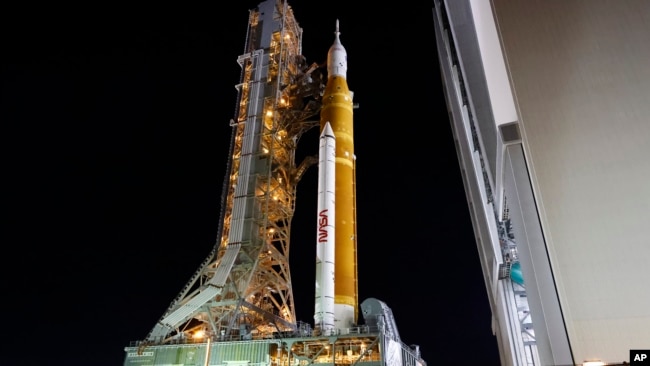アポロ17号の1972年以来、月面に人類が立ったことがないことに驚きます。
あれは夢だったのか?と思えるほどです。
2025年のこの計画は、どのような想定をしているのでしょうか。
VOAで英語を学びましょう!!
NASAが新型月ロケット打ち上げの準備を開始(和訳)
NASA Prepares for New Moon Rocket Launch
August 22,2022
アメリカの宇宙機関NASAが、人類を月に戻すことを目的とした新型ロケットの打ち上げに向けて最終準備を進めています。
NASAは、スペース・ローンチ・システム、SLSを、これまでに作られた中で最も強力なロケットと説明しています。98メートルのロケットは水曜日にフロリダ州のNASAケネディ宇宙センターの発射施設に到着しました。ロケットは発射場までの6.5キロの道のりを10時間近くかけて移動しました。
NASAはSLSロケットの最初の打ち上げをアルテミス 1と呼んでいます。最初のミッションでは、宇宙船に乗組員はいません。SLSはNASAのオリオン宇宙船を乗せて、月周回飛行のテストミッションに臨みます。
SLSは、1回のミッションで宇宙飛行士と物資の両方を運ぶように設計された初めてのロケットです。これはNASAのアルテミスプログラムの一部で、女性初、有色人種初の月面着陸を目指すものです。
アルテミスは、2025年までにアメリカ人宇宙飛行士を月面に着陸させるという目標を掲げています。これは、1972年のNASAのアポロ17号ミッション以来、宇宙飛行士による初の月面着陸となります。
現在、NASAは8月29日の打ち上げを計画しています。ロケットの上部にあるクルーカプセルの中には、3体のマネキンが設置される予定です。このマネキンは、ミッション中の放射線や動きを測定するための一連のセンサーに接続されます。
テストミッションの間、オリオンは地球から450,600キロメートル、そして月の向こう側まで数千キロメートルの距離を移動することを目指します。NASAによると、これはこれまで人類のために作られたどの宇宙船よりも遠い距離を移動することになるといいます。ミッションの期間は4~6週間と予想されています。
SLSミッションの主な目的は、将来的に宇宙飛行士を含む飛行を行うためのシステムをテストすることです。しかし、このロケットは、科学実験を支援するための一連の有効搭載量も搭載する予定です。
有効搭載量の中には、月面の水を探すために設計されたキューブサットが含まれます。キューブサットとは、超小型衛星とも呼ばれる小型の研究用宇宙船です。科学者、政府、民間団体が宇宙実験を行うための低コストな方法を提供します。
NASAはSLSに搭載されるキューブサットをルナアイスキューブと呼んでいます。大きさは靴箱ほどで、重さは14キログラムです。
月を周回しながら、ルナーアイスキューブは、スペクトロメーターと呼ばれる装置を使って、月の氷を探し、調べます。スペクトロメーターとは、原子や分子の反応を測定するための装置です。
NASAは、水は将来の探査活動に必要な資源であるため、月の氷を探すことは重要であると述べています。宇宙飛行士は、氷を飲料水や機器の冷却に使ったり、太陽系深部へのミッションのためのロケット燃料を作ったりすることができます。
宇宙機関は、ルナーアイスキューブがレゴリス:月の岩石や塵の多い表面)からの水の吸収と放出に関するデータを求めると最近の声明で述べています。「ルナーアイスキューブがこのプロセスを調査することで、NASAは月で起きているこれらの変化を地図にすることができます。」と声明は述べています。
キューブサットはまた、外気圏を研究します。外気圏とは、惑星や月のような衛星天体の周りにある薄い外側の領域のことです。
NASAは、ルナーアイスキューブがレゴリスが収集したデータは、水やその他の物質が月面でどのような挙動を示すかについて、科学者により良い理解をもたらすと言います。この情報をもとに、研究者は月の氷に影響を与える季節変化を予測し、資源としての利用に影響を与えることができるようになることを期待しています。
NASA Prepares for New Moon Rocket Launch
The American space agency NASA is making final preparations to launch a new rocket designed to return humans to the moon.
NASA has described its Space Launch System, or SLS, as the most powerful rocket ever built. The 98-meter rocket arrived Wednesday at a launch complex at NASA’s Kennedy Space Center in Florida. It took nearly 10 hours for the rocket to make the six-and-a-half kilometer trip to the launch center.
NASA is calling the first launch of the SLS rocket Artemis 1. There will be no crew on the spacecraft during the first mission. SLS will carry NASA’s Orion spacecraft on a test mission to fly around the moon.
SLS is the first rocket designed to carry both astronauts and supplies on a single mission. It is part of NASA’s Artemis program, which aims to land the first woman and first person of color on the moon.
Artemis has a goal to land American astronauts on the moon no earlier than 2025. It would be the first moon landing by astronauts since NASA’s Apollo 17 mission in 1972.
Currently, NASA is planning for an August 29 liftoff. Three mannequins will be placed inside the crew capsule at the top of the rocket. They will be connected to a series of sensors designed to measure radiation and movements during the mission.
During the test mission, Orion will aim to travel 450,600 kilometers from Earth, and thousands of kilometers beyond the moon. NASA said this will be farther than any spacecraft built for humans has ever traveled. The mission is expected to last four to six weeks.
The main purpose of the SLS mission is to test the system for a future flight including astronauts. But the rocket will also be carrying a series of payloads to support science experiments.
Among the payloads will be a CubeSat designed to look for water on the moon’s surface. CubeSats are small research spacecraft also known as nanosatellites. They provide a low-cost way for scientists, governments and private organizations to carry out space experiments.
NASA calls the CubeSat aboard the SLS Lunar IceCube. It is about the size of a shoe box and weighs 14 kilograms.
While orbiting the moon, Lunar IceCube will use an instrument called a spectrometer to look for and examine lunar ice. A spectrometer is an instrument used to measure atomic and molecular reactions.
NASA has said the search for ice on the moon is important because water is a necessary resource for future exploration activities. Astronauts could use the ice for drinking water and to cool equipment or make rocket fuel for missions deeper into the solar system.
The space agency said in a recent statement that Lunar IceCube will be seeking data on the absorption and release of water from the regolith: the moon’s rocky and dusty surface. “With Lunar IceCube investigating this process, NASA can map these changes as they occur on the Moon,” the statement said.
The CubeSat will also study the exosphere. The exosphere is the thin, outer area around a planet or satellite object, such as the moon.
NASA says data collected by Lunar IceCube will give scientists a better understanding of how water and other substances behave on the moon. With this information, researchers hope to be able to predict seasonal changes affecting lunar ice that could affect its use as a resource.
Words in This Story
mission – n. a flight by an aircraft or spacecraft to perform a specific task
mannequin – n. an artificial human form
payload – n. the load carried by a vehicle
absorb – v. to take in or soak up something, such as water
occur – v. to happen
